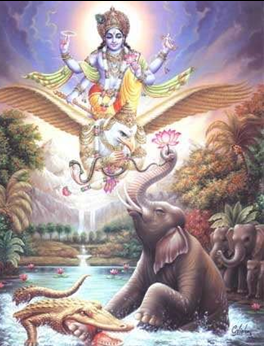Talk:Saguṇa Brahman as Īśvara or Bhagavān:Animals as Devas
By Sri Vishal Agarwal
In many other religions, animals are just considered an ‘ornament’ to human beings. It is even questioned if the animals have souls.
In Hindu dharm however, animals are regarded as living creatures with an *ātmā* like human beings, even though their minds are not as evolved as human minds.
Animals as Recipients of Divine Grace: In the Hindu tradition, animals and plants are not regarded as mere objects for wanton human use and consumption. Rather, they are equally alive just as human beings are, and deserving of Divine grace and human compassion. Numerous Hindu prayers include animals as beneficiaries of Bhagavān’s blessings and mercy.
The traditional recitation of the Ṛgveda (the first of the four Vedas – the most authoritative scriptures of people) ends with the benedictory words ‘‘śam catuṣpade’’ (‘May Bhagavān give peace to the quadrupeds’). The very first section of the second Veda, the Yajurveda 1.1, ends with words ‘‘yajamānasya paśūn pāhi’’, which asks Bhagavān to protect the animals belonging to the worshipper.
Several "Śāstra"s such as the Purāṇas describe instances of animals earning salvation due to their devotion to Bhagavān. For example, the Gajendramokṣa episode in the Bhāgavata Purāṇa 8.3 narrates the miraculous devotion of an elephant, which caused Bhagavān Viṣṇu to manifest and grant salvation to the creature.
It is a very common practice to have animals blessed by priests in temple compounds.
The Bhagavān in Animal Form, Animals as Helpers of the Divine: In Hindu Dharm, Bhagavān Himself is said to have manifested in the animal form several times to save human beings and the creation in general. For example, Bhagavān Viṣṇu incarnated as a tortoise, fish, boar, and a half-lion.
Even when Bhagavān is said to have manifested in a human form to protect truth, animals are said to have contributed in many ways in furthering His purposes and tasks. As a result, many animals are considered sacred by people, and killing them is forbidden. For example, monkeys are sacred creatures for people because one of their kind, Bhagavān Hanumān, a very popular Hindu deity, is considered an exemplary devotee who served Bhagavān Rāma (a manifestation of Bhagavān) and helped Him achieve His divine goals as narrated in the Hindu epic Rāmāyaṇa. The Sundara Kāṇḍa section of this epic narrates the deeds of Hanumān and is singled out for public recitation by people even today.
Interfaith Perspectives: Many non-Hindus are perplexed and even repelled by the fact that several Hindu deities are depicted as animals, plants or anthropomorphic. However, people do not see any incongruity in these representations of the Divine. A modern scholar explains:
“Because some of these deities are shown with animal faces, it does not mean that people worship animals or promote animal behavior. The reason why these animals are shown with the deities is to promote the idea of the sacredness of all living things. People disagree with the teachings of some religions that Bhagavān has made animals and birds purely for the consumption of mankind. People go along with the theory of evolution that we are a continuation of the animal kingdom and this reverence for life should be extended to the animal kingdom.”[1]
A guide directed[2] towards people who participate in interfaith events says:
“An exploration of other ancient faiths shows that Hindu Dharm is not alone in having Divinities with animal attributes. The ancient Greeks worshipped the Bhagavān Pan, who has the hindquarters, legs and horns of a goat, and the sea Bhagavāns Ichthyocentaurs, with human heads and torsos, the front legs of a horse and the serpentine tails of fish. In Egypt’s pantheon, Anubis (the Sun Bhagavān), Thorth (Bhagavān of Wisdom and of the Moon) has the head of an ibis or a baboon, and His consort, Bastet, has the form of a cat or a lioness. The Mesoamerican people worshipped Quetzalcoatl, a feathered serpent. The Assyrians feared the powerful serpent goddess Tiamat and revered various winged beings. In Japan – where Buddhism and Shintoism are intertwined – Kitsune the fox and Tengu the bird man are powerful shape-shifters who can transform into human or inanimate shapes to trick humans. Many shrines there are guarded by a pair of magical lion-dogs known as the Koma-in or Shishi.
… Christians, who tend to ridicule Hindu Dharm on this point, … can recall that winged angels are half-human and half-bird. Four-headed beings called Cherubins were central in the early Christianity. In the Bible’s Book of Revelation, John writes: “I saw a throne standing in heaven; and the One who was sitting on the throne… In the center, grouped around the throne itself, were four animals with many eyes, in front and behind. The first animal was like a lion, the second like a bull, the third animal had a human face and the fourth animal was like a flying eagle. Each of the four animals had wings….” (4:1–8). The description matches an account by Jewish prophet Elijah centuries before. Importantly, these beings are the most powerful beings in the pantheon, closest to the Creator.”


